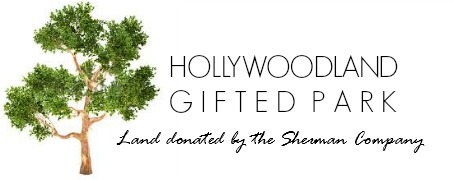The Hollywoodland Tract was developed as a self-contained planned, hillside community where property owners could live, relax and socialize. The Hollywoodland Riding Stables at the end of Beachwood provided horseback riding and access to the bridle trails in Hollywoodland proper, interconnecting the public space of Griffith Park and the reservoir’s dam. Original tract maps show bridle trails were created by Engineering Service Corporation, the same concern engineering Hollywoodland’s roadways . The Lawson horse ranch and cottage was located in the eastern section of the tract accessed from the only entrance into the HGP, Canyon Drive. Once the land was deeded to the City the ranch was disbanded and the area cleared away to make room for a public children’s camp. Today, this entrance has two parking lots, bathroom facilities, water for hikers and the Hollywoodland Girls Camp. Remnants of the rock quarry’s scars and its cave are still evident.
Two tennis courts and a putting green existed from the 1920’s through the 1960’s. They were located at the east end of Beachwood Drive, north of Linforth Drive. These lots were interlaced with the signature Hollywoodland granite. When the Sherman Company dissolved its interests in the 1960’s, these lots were sold for the purpose of residential development. In 1963 a new tract 25663 was created re-subdividing the parcels into 16 different lots.
This new development created an extension of Hollyridge Drive into Beachwood Drive that never existed. It involved meeting the City’s engineering standards for roadway and subdivision of single family residential homes. Road access for the (aka Hollywoodland Riding Stables) Sunset Ranch remained in place, grandfathered through the long term 1940’s era easement ( #17784).
Early Hollywoodland property owners had access and use of the Norman Castle on Rodgerton Drive, a model home designed by architect John DeLario. In the 1940’s it was sold and later burned in the 1961 fire.
Image courtesy of Greg Williams, Story of Hollywoodland
